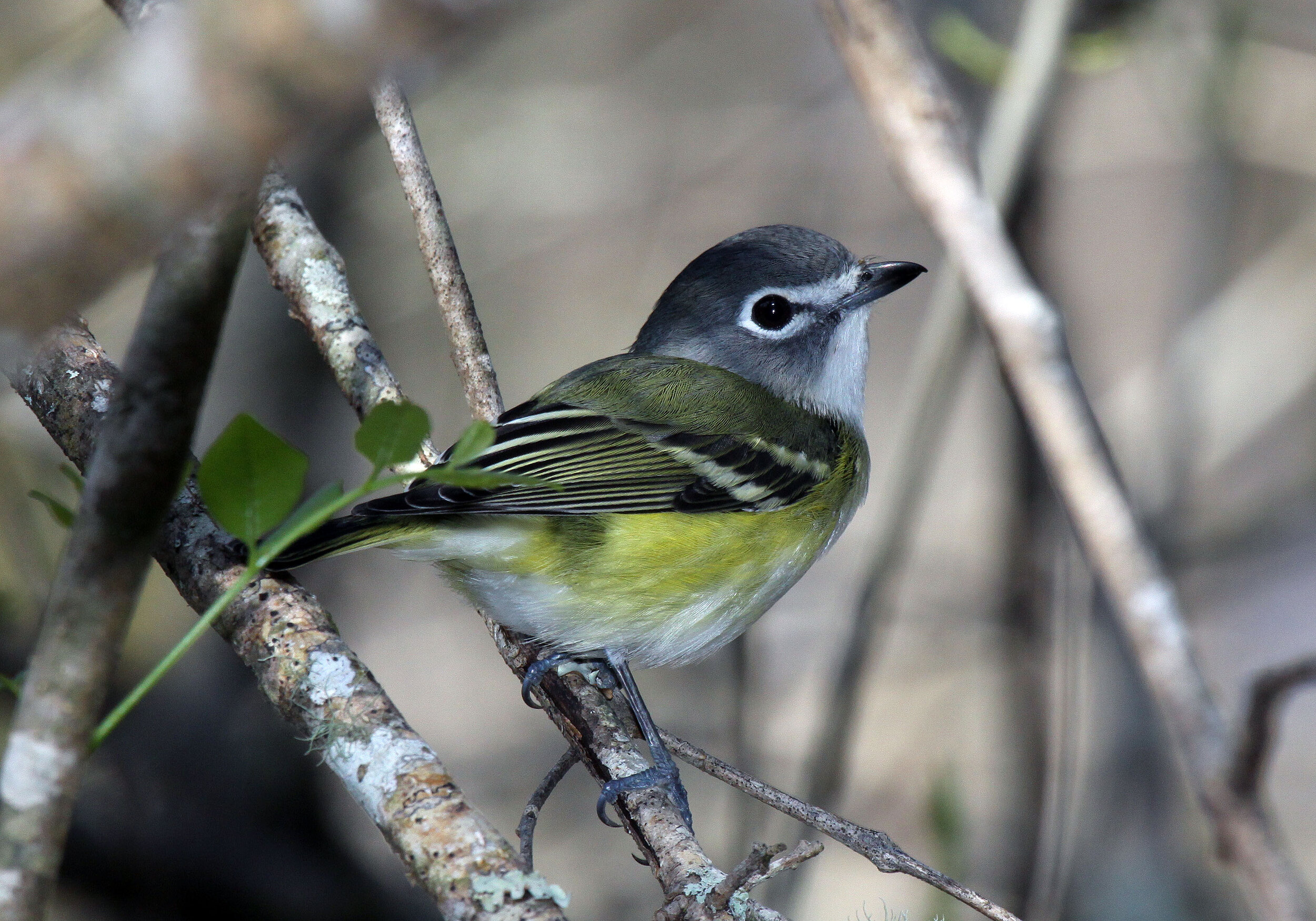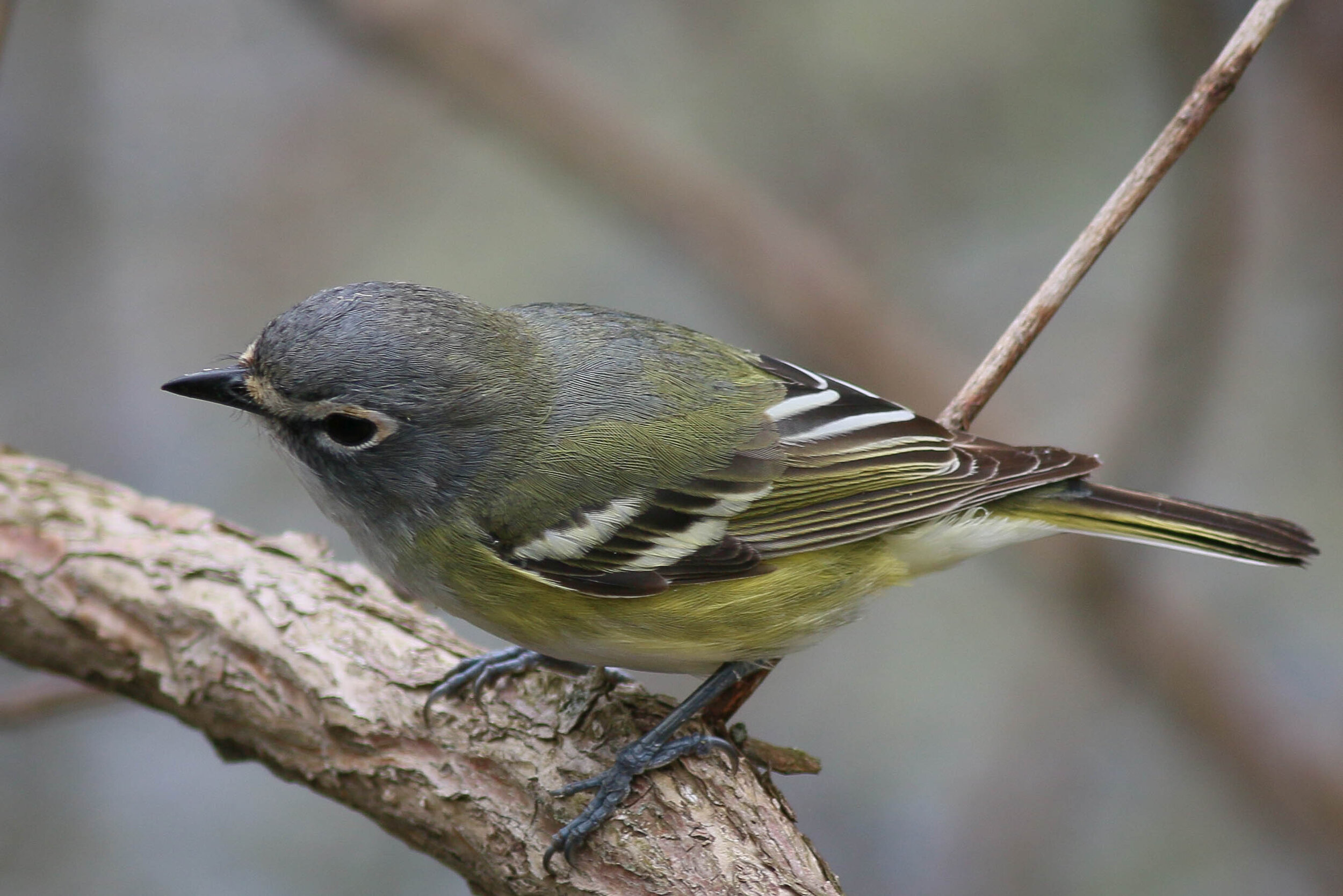This is a reprint of the Blue-headed Vireo article from October 18, 2019. Yay vireos!
The world over, how many birds have blue heads? Most of those birds, one might imagine, are located in the tropics—nestled away in exotic rainforests. A quick “blue-headed” query into eBird reveals blue-headed wood-doves, coucals, hummingbirds, sapphires, bee-eaters, parrots, macaws, and racquet tails, among a legion of other blue-headed birds. Most of these birds are indeed tropical, ranging from West Africa to Colombia to Caribbean endemics.
One bird with a blue head can be found in Wisconsin, among nine or so others, breeding in the northern mixed conifer forests in summer, and migrating through southern Wisconsin in October and early May. The blue-headed vireo makes a relatively early migration through the southern part of Wisconsin, typically in late April to early May. Abundant caterpillars on leafing out trees provide a rich source of protein, and the bird’s preference for nesting in conifer trees is due at least in part to the available foliage to conceal nests for this early-arriving species.
Blue-headed vireo, photo by Melanie
In many ways, the blue-headed vireo is anomalous among passerines. Its Latin name (Vireo solitarius) hints at its former common name (Solitary vireo), and these birds live up to their solitary reputation, with males defending wide-ranging territories of northern forestland, up to 15 acres at a time. Additionally, males will build many nests as part of their courtship behavior, with the female finally choosing the male with the best-built nests and most well-defended territory. Perhaps due to the male’s outstretched territory and nest building, the female actually weighs more than the average male, which is rare in songbirds.
Another distinguishing characteristic is the blue-headed vireo’s call note while on the nest, allowing researchers easier detection of these birds on their breeding grounds. This bird’s typical song slightly resembles the red-eyed vireo, but Roger Tory Peterson has called it “more deliberate, softer, and sweeter.” Learning the intricacies of vireo song and plumage can be a launchpad into advanced birding, and as this article writes, the red-eyed vireo—which ceaselessly sings all summer long in eastern forests—is the basis for differentiating vireo songs.
While breeding bird survey routes in northern Wisconsin have shown slight increases in the abundance of blue-headed vireos, their outlook is not all positive. Numerous factors will threaten this bird in the coming decades. At the forefront is climate change. National Audubon’s new Climate Report shows dire predictions for hundreds of North American bird species. An interactive online tool allows you to see the impacts to birds in your zip code, and a look at the blue-headed vireo shows a huge range reduction and movement north (below, photo courtesy of Audubon.org/climate/survivalbydegrees).
This map from Audubon’s Survival by Degrees website shows the blue-headed vireos habitat loss and gain in North America, under a 3 degree warming scenario. Provided by National Audubon Society.
While today, these birds find breeding habitat in the southern Kettle Moraine at 43 degrees north, a predicted warming of three degrees Celsius will result in blue-headed vireos moving at least 17 degrees north—if they can even make it that far.
Another concerning focus of the conservation of blue-headed vireos is the proliferation of an invasive species, the hemlock wooly adelgid. Introduced from East Asia, this bug sucks sap from trees and kills its host within 4-10 years. This bug has devastated eastern forests with hemlock, however; Wisconsin is at the western edge of the range of hemlock, and has yet to report any incidence of hemlock wooly adelgid.
Map of eastern hemlock’s native range, courtesy of USDA Plants Database
The map above shows the range of eastern hemlock in the United States. The gap in the species range across the Midwest may inhibit the spread to Wisconsin, in addition to the Great Lakes buffering its spread. Yet, populations of this bug have been found in western Michigan.
In Wisconsin, hemlock has been increasing since the cutover at the start of the 20th century. The graph below shows the volume of hemlock in the state increasing since the 1980’s, and a continued increase of up to 40% is projected for the next few decades, which could benefit blue-headed vireos.
Graph from WDNR Division of Forestry Report, October 2017
While other coniferous trees may harbor blue-headed vireos, it may be of no consequence unless greenhouse gas emissions are curtailed.
Blue-headed vireo, photo by Skip Russell
Here at Faville Grove, I saw a singular blue-headed vireo in Faville Woods just last week. I got fantastic up-close looks at the bird as it foraged through the trees just a few feet in front of me, apparently gleaning insects. This bird is a true delight on its spring and fall migration (it has a blue head!) and would be a somber loss from our mixed conifer forests of the north.
Written by Drew Harry, Faville Grove Sanctuary land steward
Cover photo by John Sutton










